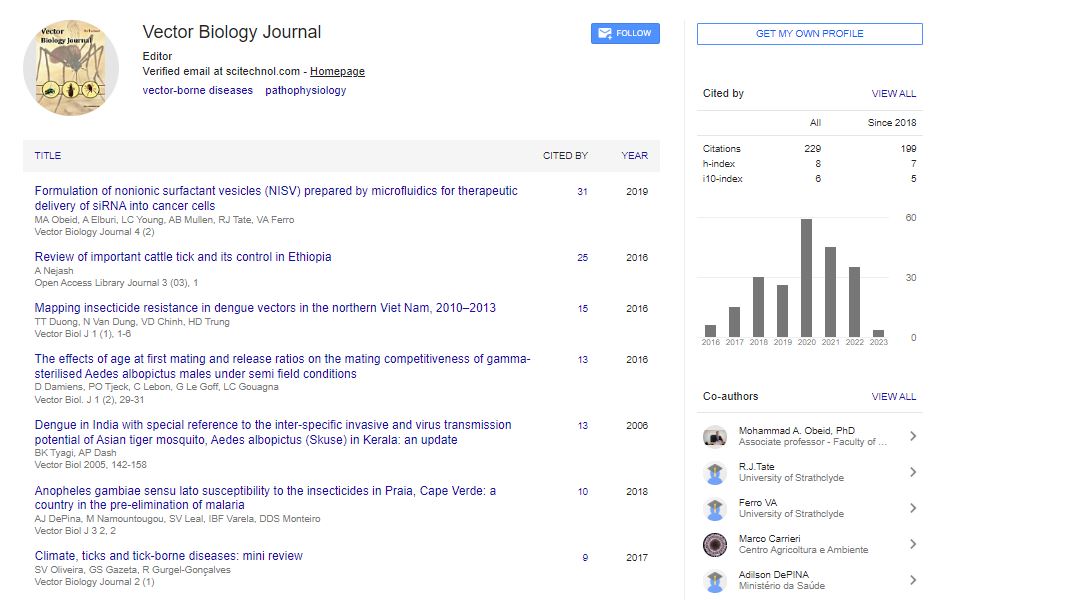Opinion Article, Vector Biol J Vol: 8 Issue: 4
Evaluating Chikungunya: Epidemiology, Symptoms, Treatment, and Prevention
Zhou Hung*
1Department of Epidemiology, Chengdu University of Traditional Chinese Medicine, Chengdu, China
*Corresponding Author: Zhou Hung,
Department of Epidemiology, Chengdu
University of Traditional Chinese Medicine, Chengdu, China
E-mail: hung.zho@gmail.com
Received date: 21 November, 2023, Manuscript No. VBJ-24-127984;
Editor assigned date: 23 November, 2023, PreQC No. VBJ-24-127984 (PQ);
Reviewed date: 07 December, 2023, QC No. VBJ-24-127984;
Revised date: 15 December, 2023, Manuscript No. VBJ-24-127984 (R);
Published date: 22 December, 2023, DOI: 10.4172/2473-4810.1000278.
Citation: Hung Z (2023) Evaluating Chikungunya: Epidemiology, Symptoms, Treatment, and Prevention. Vector Biol J 8:4.
Description
Chikungunya is a mosquito-borne viral disease that has increasing awareness in recent years due to its expanding geographic distribution and its significant impact on public health. The word "chikungunya" is derived from the Kimakonde language, meaning "to become contorted," reflecting the characteristic symptom of severe joint pain experienced by those infected with the virus.
Epidemiology of chikungunya
Chikungunya is caused by the chikungunya virus, a member of the Alphavirus genus in the Togaviridae family. The virus is primarily transmitted to humans through the attacks of infected Aedes mosquitoes, particularly Aedes aegypti and Aedes albopictus. These mosquitoes are widespread in tropical and subtropical regions, including parts of Africa, Asia, the Indian subcontinent, and the Americas.
Historically, chikungunya was concentrated in Africa and Asia, but in the past two decades, the virus has spread to new regions, including Europe and the Americas. This expansion is attributed to various factors, including increased international travel, urbanization, and climate change, which create favorable conditions for mosquito proliferation and viral transmission.
Clinical manifestations
The incubation period for chikungunya typically ranges from 2 to 12 days following the mosquito attacks. The development of symptoms is abrupt and may include fever, severe joint pain (arthralgia), muscle pain, headache, fatigue, nausea, and rash. The joint pain associated with chikungunya can be debilitating and may persist for weeks to months, leading to significant morbidity and impaired quality of life.
While chikungunya is sometimes fatal, the severity and duration of symptoms can vary widely among individuals. Certain populations, such as infants, the elderly, and individuals with underlying medical conditions, may be at higher risk of complications, including severe joint inflammation and neurological manifestations.
Diagnosis
Diagnosing chikungunya can be challenging, as its clinical presentation overlaps with other mosquito-borne illnesses such as dengue fever and Zika virus infection. Laboratory tests, including Polymerase Chain Reaction (PCR) assays and serological tests to detect specific antibodies against CHIKV, are commonly used to confirm diagnosis. Molecular techniques such as Nucleic Acid Amplification Tests (NAATs) provide immediate and accurate detection of the virus during the acute phase of infection, while serological assays help to identify previous exposure to the virus.
Treatment
There is currently no specific antiviral treatment available for chikungunya. Management primarily focuses on relieving symptoms and supportive care. Non-Steroidal Anti-Inflammatory Drugs (NSAIDs) such as ibuprofen and acetaminophen are commonly prescribed to alleviate fever and joint pain. However, caution should be exercised when using NSAIDs, especially in patients with underlying renal or gastrointestinal conditions.
In severe cases of chikungunya with complications such as severe joint inflammation or neurological manifestations, hospitalization may be required for close monitoring and specialized care. Intravenous fluids and corticosteroids may be administered to manage severe symptoms and reduce inflammation.
Prevention
Preventing chikungunya relies on vector control measures to reduce mosquito populations and minimize human-mosquito contact. This includes eliminating reproductive locations, such as standing water containers, using insect repellents, wearing long-sleeved clothing, and installing screens on doors and windows to prevent mosquito entry.
A community-based intervention, such as mosquito surveillance programs and public health education campaigns, plays an important role in raising awareness about chikungunya and advancing preventive measures. Additionally, research efforts aimed at developing vaccines and novel vector control methods are determined efforts to combat the spread of the virus and reduce the burden of chikungunya on affected populations.
 Spanish
Spanish  Chinese
Chinese  Russian
Russian  German
German  French
French  Japanese
Japanese  Portuguese
Portuguese  Hindi
Hindi 